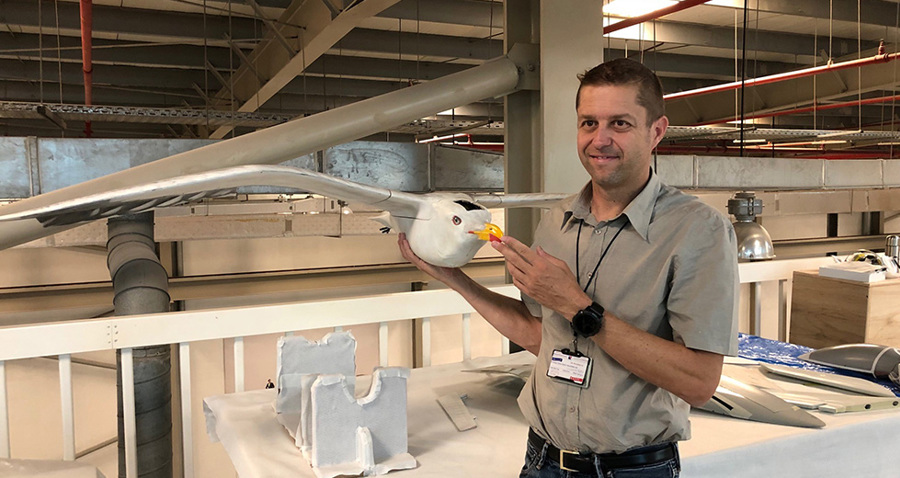
When constructing a robotic bird for surveillance purposes for the RoBird® company, aviation expert ENATA turned to Diab for a lightweight material.
Perfectly blending into its surroundings, Larus, an unmanned aerial vehicle (UAV) designed by ENATA for the RoBird® company, is modelled after a great black-backed gull. With a high degree of autonomy and optimized for unobtrusive surveillance, Larus is available with different kinds of technology depending on application.
ENATA
Based in the United Arab Emirate and designing and constructing some of the world’s most advanced unmanned aerial vehicles (UAV), radio-controlled planes and flying boats, ENATA’s Aerospace division is at the forefront of aviation technology. ENATA Aerospace products use modular carbon fiber bodies and are entirely built and assembled at the company’s manufacturing site to deliver precision and accuracy in flight.
The RoBird® company
Formerly known as Clear Flight Solutions, the Dutch company specializes in effective wildlife management services using birdlike UAVs. Founded in 2012 as a spin-off of the University of Twente, it uses the powers of nature and new technology to solve bird population problems and surveillance needs.
The project: a robo-bird for surveillance purposes
Aves is a family of UAVs for surveillance purposes, based on a biomimicry concept. They are designed to replicate large birds and can be had as a seagull, an eagle, a vulture or a stork, depending on the region in which it will be used. Applications include classic ISR (intelligence, surveillance & reconnaissance), infrastructure control & monitoring, search & rescue, as well as surveying & remote sensing.
With an electrically powered airframe and a pusher propeller located in the tail, the UAV mimics the flight of a soaring bird, and other animals react to it as though it were real. Designed to be inconspicuous in any geographical area, the UAV comes with technical functionality optimized for surveillance. Based on the intended use, it’s possible to add a camera for daytime surveillance, for nighttime light conditions, or a camera featuring IR. Other sensors can be added on demand.
The UAV is equipped with a modern autonomous navigation system and real time feed. To protect the optics during takeoff and landing, the payload is located on a revolving system. A truly unique invention, it has the realistic appearance and weight of its living counterpart and a flight performance comparable to real birds. To make it thus lifelike, the body and the wings of the robotic bird need to be carefully designed in thin layers, and together with Diab, ENATA has managed to create a sandwich composite solution that meets all requirements.
The solution
Strength and weight are two critical factors to get the accuracy and authenticity needed. ENATA has used Diab’s ultrathin “skived” sandwich composite cores for the body and wings of the Larus, made from Diab’s Divinycell F40, chosen for its low weight and fine cell structure, and Divinycell MX 10/8, selected for its equally low weight and temperature performance. The advantageous features of the material in combination with Diab’s service offering, support and willingness to work with very thin “skived” thicknesses made Diab the obvious partner for ENATA. The result is a lifelike UAV that combines new technology, superior design and material handling, as well as ornithology expertise.
Divinycell F and Divinycell MX
A recyclable, prepreg-compatible sandwich core with excellent Fire, Smoke & Toxicity (FST) properties, Divinycell F is suitable for commercial aircrafts interiors and other applications where light weight is key. It improves lifetime cost while decreasing environmental impact and offers excellent FST (Fire, Smoke & Toxicity) properties.
Divinycell MX is an all-purpose grade with high strength-to-weight ratio and is used in multiple industries, including wind and marine. Allowing you to create more effective designs according to your specific needs and requirements, it offers higher application efficiency, decreased environmental impact and decreased lifetime cost.
Facts UAV Larus:
Span, 2.5 m
Takeoff weight: 2.5 kg
Payload: 500 gr
Cruise speed: 43 km/h - 12 m/s
Range up to 40 km
Can fly up to 90 min
